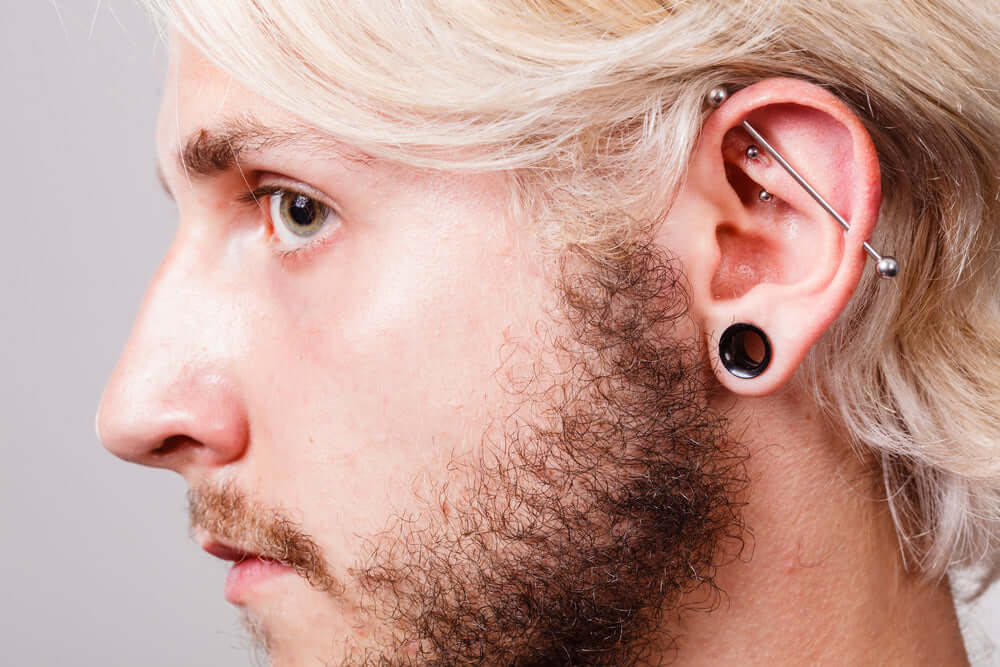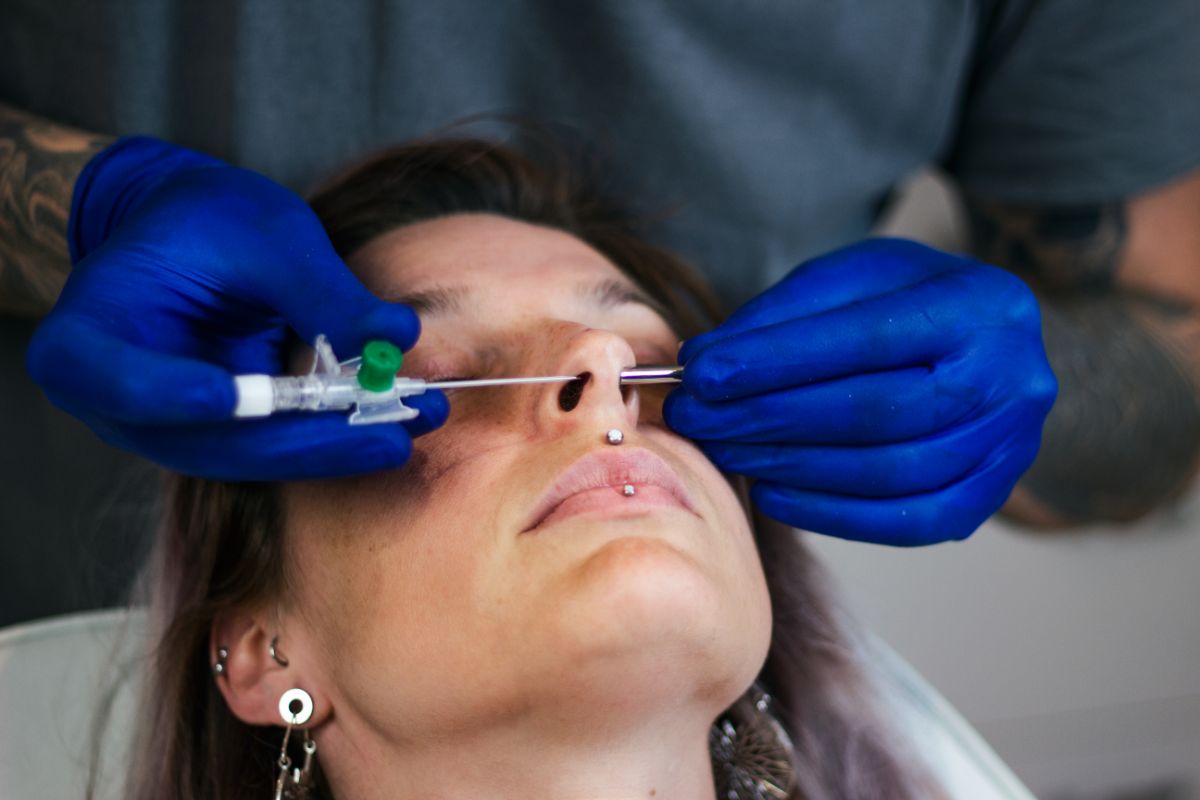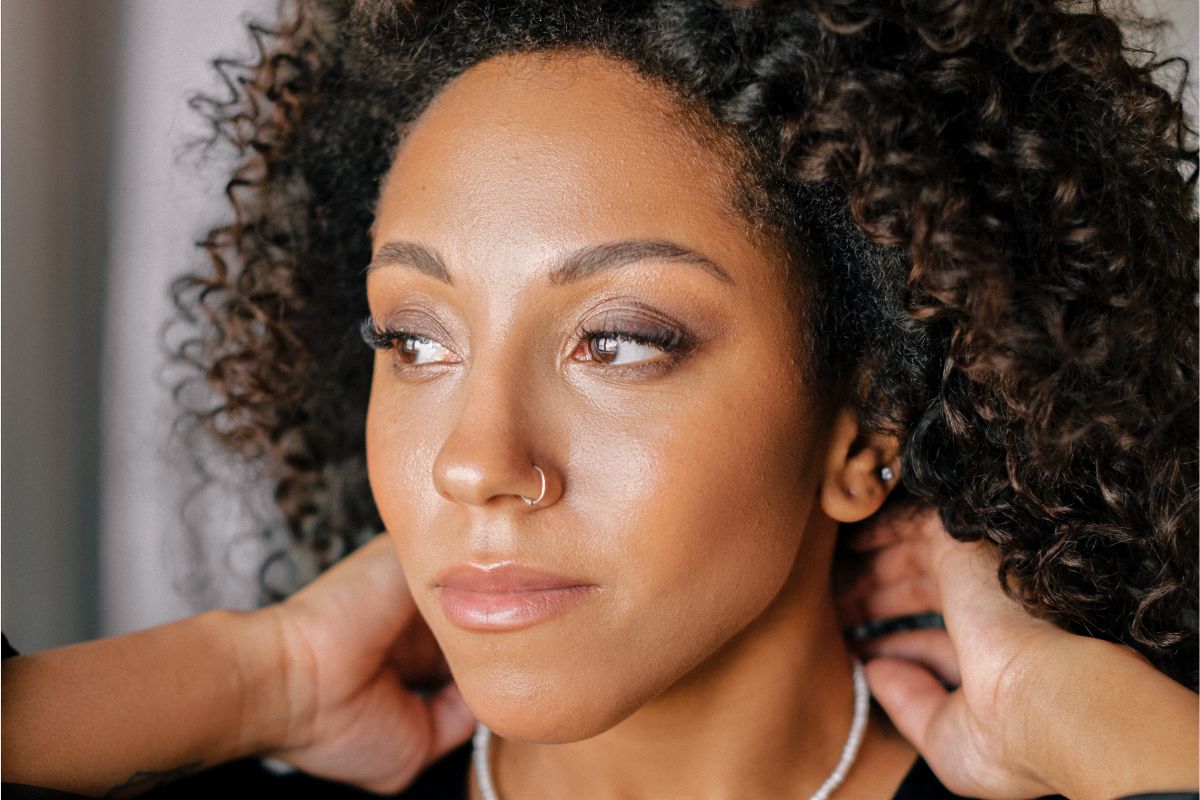Industrial piercings are becoming increasingly popular. They are a type of piercing, which is placed onto the ear, but rather than having a single hole, they use two holes that go through the cartilage of the ear. These two holes are then linked by a barbell, so it kind of just looks like there’s a small bar running across the top of the ear, from one hole to the other.
Of course, there is variety, so although they traditionally run across the top of the ear, you can also choose to have your industrial piercing placed vertically, to run down through the edge of the ear, or similar.
Usually, the bar has a ball on each end (at the other side of the hole), that is used to stop the bar from slipping out of the holes and falling off.
To many, any kind of piercing can seem like a risk, and most piercings will cause some degree of pain or discomfort when they are being done, and during the healing process. But some piercings are more dangerous than others, so what about industrial piercing? Is it dangerous?
Let’s look at some of the main risks of an industrial piercing:
- As it’s two holes, instead of one, the industrial piercing requires twice the amount of care, and twice the amount of cleaning and healing. This means that it has more chances of developing complications, or of going wrong!
- As the piercing is done on the cartilage of the ear, rather than on the skin, it can lead to excessive bleeding and will take longer to heal. (But don’t worry, the bleeding won’t be excessive enough to cause you any real harm!)
- Industrial piercings can cause long-lasting skin problems, and you could end up with a big scar, or develop keloids. (This will mainly be an appearance issue, as some can then feel self-conscious of these visible marks).
- As it’s two holes, but one piercing, many are tempted to treat them as one, meaning they don’t go through the full healing routine with both holes at 100%. So essentially, this piercing causes more of a risk of improper healing.
Despite the risks, the piercing isn’t classed as an especially dangerous one in any way. Using the right aftercare will significantly reduce and help avoid all of the possible issues that we will cover below. One of the most highly recommended after products for this, is the Dr. Piercing Aftercare, as it cleans, soothes, and protects. All in one. Plus it is FDA approved, and completely safe to use!
Do industrial piercings get infected easily?

One of the biggest risks and issues that a piercing can cause, is an infection. And that is what the healing process aims to avoid at all costs. Different types of piercings have higher or lower chances of infection, so where does the industrial piercing stand?
As the industrial piercing is placed on the ear cartilage, it is more prone to infection than other types of piercings. This is because the cartilage takes longer to heal, and also because this means the piercing is usually closer to the hair. Contact with your hair can then increase the risk of infection, because the hair can get tangled in the piercing, moving it around and irritating the holes, and it can also spread dirt and oil.
Also, as the industrial piercing has two holes, instead of one, it has double the amount of chances of developing an infection. So to answer the question directly: yes, industrial piercings can get infected easily. (Or at least compared to other types of piercing).
Should I move my industrial piercing while cleaning it?
If you move your industrial piercing, or fiddle with it while it’s still in the healing process, it will get irritated pretty fast and can lead to further issues. So although it is inevitable for your piercing to move now and then, it’s important that you’re not moving it on purpose.
However, it is also incredibly important to clean your industrial piercing thoroughly and properly, on a regular basis. As it has a higher than average risk of infection, you cannot skip out on the regular cleaning, and you should do it carefully. But does this mean you should be moving the industrial piercing while cleaning it?
No. You should not. You can clean the industrial piercing, using whichever method is best for you, without moving the piercing itself more than necessary. You might have to slightly move the piercing, which is fine, as long as you do so carefully and gently. But there’s no need to move the piercing more than necessary, and no need to worry about whether the cleaning solution will get under it or not.
Some people believe that you should move the piercing in order to stop the hole from over-healing, or closing. This is completely untrue. As long as the piercing is in your ear, the holes will heal around it, and will not close. There is therefore no need whatsoever to be moving your piercing around.
Why is my industrial piercing crusty?
After a piercing, it is completely normal to find a crust forming around it during the healing process. This is essentially the body trying to heal itself, and the crust is just a combination of dead blood cells and plasma, which come out to the surface and then become dry when exposed to the air.
A crusty piercing, therefore, is completely normal, and nothing to become worried about.
However, this does not mean that you should just leave the crust be. It is very important that you thoroughly clean away the crusty bits, in a gentle and careful manner so as to not irritate the piercing. Otherwise, they will pile up around the piercing, and will eventually block it and prevent it from healing properly.
So essentially, you just need to keep cleaning the crust that forms away, and eventually less and less crust will form until the piercing is completely healed and no more crust appears.
This process can vary between each person, so some might not even get much crust around the piercing at all! For some, the piercing will become crusty for a few days, and for others, it will take weeks. There’s no need to worry about it as it is completely normal, and should eventually disappear.
But just to be on the safe side, you should check that the crust is clear or a pale yellow in color. If the piercing is oozing out in a darker yellow, or even brown, it could indicate that it has an infection.
Why does my industrial piercing smell?
Sometimes, your industrial piercing can smell bad. (Like, really bad). But don’t worry. This is something that can happen with all types of piercings, and it’s part of the healing process.
The reason why piercings can smell bad is that your body is secreting sebum, a substance that comes from the sebaceous glands in the skin. This is an oily substance that lubricates and waterproofs the skin.
This is something that happens on a daily basis and is part of bodily functions. So why does it cause the piercing to smell bad?
Well, when the sebum substance mixes with the dead skin cells and the bacteria around the piercing (as it is in its healing process), it suddenly becomes a very stinky and semi-solid discharge.
But don’t worry. There is a very easy way to get rid of this smell, and a very easy way of reducing it: cleaning your piercing out regularly and thoroughly. If you remove the dead skin cells and the bacteria that cause the substance to become smelly, then the piercing will stop smelling as bad. So just remember to keep up the cleaning routine, and to clean extra thoroughly if you’re having this problem.
Why does my industrial piercing have a bump?
Right after you get an industrial piercing, your body will rush to try and heal the damage caused to the ear cartilage. This healing process includes inflammation and swelling, which can cause the piercing to have a very noticeable bump.
Don’t worry, this is completely normal, and happens with other types of piercings too.
Over time, as the piercing heals and the swelling goes down, the bump should disappear.
However, an industrial piercing can develop other bumps after the healing process is complete, which can be a sign of infection, or can be the scarring of the cartilage (in which case the bump will be permanent).
Why does my industrial piercing itch?
During almost any healing process, be it a piercing, or a tattoo, or any other type of wound or damage done to the body, you will experience itchiness. This is a completely normal part of the healing process, and it’s pretty much inevitable.
The reason why the area that is healing begins to itch is that it is accumulating dead skin, which is rising to the surface as the wound heals. It is very important not to scratch at the piercing when it itches, as this will just further irritate the piercing, will increase the itch, and will cause more of a risk of it becoming infected or not healing properly.
Instead, if the itch is becoming hard to bear with, clean the piercing. Rinse it under the shower, or run water over it. This will wash away the excess dead skin cells and should reduce the itching considerably.





